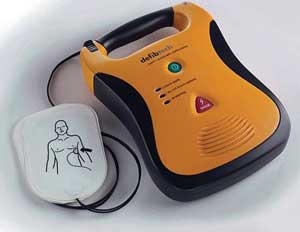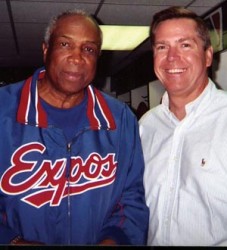Commotio Cordis, Rare But Potentially Lethal
By SpaceCoastDaily // June 16, 2012
Sports Medicine
(Video by USLacrosse)
EDITOR’S NOTE: A year ago tragedy struck the baseball field in Arizona when a 13-year-old Little Leaguer was trying to bunt and was hit on the chest by the pitch. He took a few steps towards first base and then collapsed. He died the next morning.
Getting hit by a pitch is to be expected when playing baseball. Dying is not. The Arizona boy suffered from commotio cordis, which is Latin for “agitation of the heart.”
Commotio cordis is a disruption of heart rhythm that occurs as a result of a blow to the area directly over the heart. From 1996 to spring 2007, the USA National Commotio Cordis Registry recorded 188 cases. Fewer than 20 percent survived.
We are delighted to welcome Dr. Bruce Thomas, who practices sports medicine at MIMA Orthopedics and Sports Medicine, to address questions related to this rare, but often fatal injury.
Dr. Thomas is a Senior Consultant and Spring Training Team Physician for the Washington Nationals, and also the Head Team Physician for the Brevard County (Florida) Manatees, the Class A Affiliate for the Milwaukee Brewers.
SpaceCoastDaily.com: What is the mechanism of injury involved with commotio cordis?
DR. THOMAS: It is believed to be an electrical event, which occurs when a ball or other projectile hits the chest in the right place during the right moment of the cardiac electric cycle causing a sudden change in heart rhythm. Blood flow essentially stops. When it stops to the brain, in seconds, the patient becomes unconscious. When it stops elsewhere it results in rapid death.

SpaceCoastDaily.com: Why does the heart respond that way?
DR. THOMAS: Although the exact mechanism of what occurs is unknown, it is believed that sudden death is due to an electrical event, most likely ventricular fibrillation (VF) occurring immediately upon chest wall impact. Ventricular fibrillation is like a bowl full of worms wriggling. Not a coordinated synchronized beat like the normal heartbeat.
SpaceCoastDaily.com: Would it have mattered a split second or two later?

DR. THOMAS: That’s a very good question and the answer is unknown. It is, however, felt that the timing of impact of the blunt chest trauma is important in the mechanism of commotio cordis. There is only a 20 to 40-millisecond window on the up slope of what we call the T wave (early repolarization of the ventricles-lower chambers). This has been worked out through experimental models. Interestingly, the velocity also seems to be important. A velocity of at least 40 mph appears to be necessary to cause the event.
SpaceCoastDaily.com: Is the heart actually damaged or has it just stopped?
DR. THOMAS: For the most part, autopsy studies of these cases have shown a normal heart.
SpaceCoastDaily.com: Is a ball hitting someone’s chest similar to doing CPR (chest compressions) on someone with a beating heart?
DR. THOMAS: The velocity that’s required to cause commotio cordis is a minimum of 40 miles an hour. This is significantly higher impact than doing chest compressions during CPR.
SpaceCoastDaily.com: Realistically, how hard does a ball have to hit someone to stop the heart?

DR. THOMAS: Although the answer to this question is not definitively known, as mentioned, it appears that the minimum velocity to cause commotio cordis is 40 miles per hour. This explains why the vast majority of these cases occur in young persons (the mean age is 15 years old), and why 75 percent of cases have occurred during athletics involving blunt projectile such as baseball, lacrosse, and hockey.
SpaceCoastDaily.com: What’s the anatomic danger radius around the heart?
DR. THOMAS: Only impact occurring directly over the cardiac silhouette results in ventricular fibrillation, so it appears that the impact must occur directly over the heart.
SpaceCoastDaily.com: Why was this Arizona boy’s heart not able to be restarted as fast as it was stopped?
DR. THOMAS: If indeed this is caused by ventricular fibrillation, that rhythm usually requires intervention to revert back to a normal rhythm, and does not do so spontaneously. Because a heart in ventricular fibrillation does not pump blood normally, if at all, the person dyes very rapidly without intervention such as can be provided by an Automated External Defibrillator (AED).
SpaceCoastDaily.com: Cleary, seconds count. The next time this happens can a player be resuscitated?

DR. THOMAS: AEDs are more and more frequently seen at sporting events, and are required at most professional ball games. This may indeed allow us to resuscitate an athlete with commotio cordis, but the intervention would have to be done extremely promptly, and the rescue personnel would have to be fully trained in advance on the use of the device. That day may come.
SpaceCoastDaily.com: This type of tragedy seems to happen only in young players. Are Major League Baseball and other professional athletes at risk?
DR. THOMAS: Major League Baseball players generally fall above the age range of most commotio cordis cases. We do know that younger patients are in the risk “target zone” and not older athletes. There has not been an instance of commotion cordis in Major League Baseball.
SpaceCoastDaily.com: With 20 years of experience in Major League Baseball, do you know if protocols are in place if this were to happen? If so, what are they?
DR. THOMAS: All MLB trainers, and some coaches are trained in CPR and AED use. We have protocols to ensure that the AEDs are working properly and we also have AED practice sessions and CPR review sessions usually during spring training. If this were to occur during a Major League game, it would be handled the same as any other sudden loss of consciousness. With trained personnel and proper equipment very close at hand the likelihood of survival would be high.
SpaceCoastDaily.com: What about locally?
DR. THOMAS: All Brevard County (Florida) High Schools have AEDs available. Typically there are three on campus, including the athletic facilities. People undergo training to use them, but they are very simple to use and actually include voice instructions to assist anyone in its effective use.
SpaceCoastDaily.com: In your opinion, what are the keys to preventing this tragedy?
DR. THOMAS: Unfortunately, and surprisingly, commercially available chest wall protectors have not been shown to effectively prevent commotio cordis. Many of the commotio cordis victims reported to the national commotio cordis registry were indeed wearing protective equipment at the time of their event. Coaching measures should encourage batters to turn away from oncoming projectiles whenever possible to avoid contact directly over the heart. Softer and less dense balls should be used whenever possible without changing the nature of the game. Age-appropriate safety baseballs have indeed been shown to decrease the risk of commotio cordis.
ABOUT DR. BRUCE THOMAS
Dr. Thomas has blended his love for medicine with his passion for sports. A stint at the Beijing Olympics, where he served as physician for the Chinese baseball team, is among the adventures for this family practitioner and sports medicine specialist.

Dr. Thomas has worked with some of the world’s top athletes including Barry Bonds, Josh Beckett and superstar golfer Annika Sorenstam, who is a family friend.
For Dr. Thomas, the field of dreams began with a family practice in Indialantic, Florida when he also began volunteering as a sideline doc for Melbourne High School teams.
“I wanted to be a professional baseball player, but I realized in college, when I got to a level that I was mediocre compared to the competition, and that was going to be it,” said Thomas, who attended Tulane for his undergraduate degree and remained there on for medical school.
When Thomas began working with the Mel Hi teams, sports medicine was in its infancy and licensing boards were scouting for physicians who, like him, would be interested in non-orthopedic sports medicine certification.
Board certification opened up a wondrous new world of opportunities for him. “I was the only board certified sports medicine doc in Brevard County, so the Marlins approached me,” he said.
As it happened, the Marlins doc was also the Dolphins doc. Thomas thought he’d died and gone to heaven. “I got to know all the players,” he said.
Even after all these years, nothing can top the magic of the 1993 World Series games for Thomas.
“Being there for the ’03 World Series, watching guys I had worked with in the minor leagues become world champs, it doesn’t get any better than that for a guy like me,” said Thomas, who treasures his World Series ring.

When the Expos replaced the Marlins in Brevard, Thomas entered another wonderful career phase as the Expos team physician. “I basically just changed shirts,” he said.
Another of Thomas’ great gigs is his position as physician for the Women’s LPGA. “The women golfers are a delight,” he said.
Anika Sorenstam, Natalie Gulbis, Paula Creamer all visit Thomas whenever there’s a medical issue. By cell phone or e-mail, Thomas is their physician-on-call. “I’m basically their family doctor,” he said.
To reach Dr. Thomas call 321-725-4500 , ext. 7802.













In February 2012, I was on vacation in Florida. It was about February 8 when I heard about the passing of 12- year old Tyler Kopp from Upstate New York. He had been struck in the chest in late January and died on Feb 7. His passing impacted the lacrosse community and luckily, new safety gear is required in the state of New York.